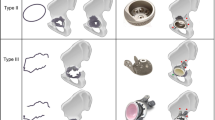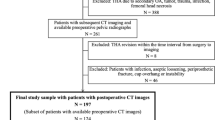Abstract
Background
To achieve sufficient socket coverage by the native bone, high placement of cementless acetabular cup is often required. We previously reported, using computer simulation, that higher hip centre improved the bone coverage but decreased the range of motion in total hip arthroplasty (THA) for patients with hip dysplasia. However, in a clinical setting, the correlation between the hip centre height and dislocation after primary THA is still unclear. We examined whether a high hip centre affects dislocation after THA.
Methods
A total of 910 patients, with 1079 dysplastic hips, who underwent primary THA were retrospectively reviewed. The age at THA averaged 63.0 years and mean follow-up was 74.3 months. Vertical centre of rotation (V-COR) was defined as the distance from the head centre to the interteardrop line. Uni- and multivariate logistic regression models were applied to identify significant factors affecting dislocation.
Results
Ten hips in nine patients (0.9%) had dislocation after THA. In univariate analysis, age at surgery and V-COR were significant risk factors for dislocation. Multivariate analysis identified advanced age at operation (odds ratio [OR] 1.8/5 years), Crowe classification (OR 15.6), V-COR (OR 3.1/5 mm), and femoral head size (OR 11.6) as independent risk factors for dislocation. Receiver operating characteristic curve analysis revealed the cutoff value of the V-COR for dislocation as 23.9 mm.
Conclusions
A higher hip centre with the V-COR > 23.9 mm affected dislocation after THA for DDH. Our results would be useful for reconstruction of the hip centre, particularly with cementless acetabular cups.





Similar content being viewed by others
References
Jolles BM, Zangger P, Leyvraz PF (2002) Factors predisposing to dislocation after primary total hip arthroplasty. J Arthroplast 17(3):282–288
Berry DJ, von Knoch M, Schleck CD, Harmsen WS (2004) The cumulative long-term risk of dislocation after primary Charnley total hip arthroplasty. J Bone Joint Surg Am 86((1):9–14
Mallory TH, Lombardi AV, Jr., Fada RA, Herrington SM, Eberle RW (1999) Dislocation after total hip arthroplasty using the anterolateral abductor split approach. Clin Orthop Relat Res (358):166–172
Berry DJ, von Knoch M, Schleck CD, Harmsen WS (2005) Effect of femoral head diameter and operative approach on risk of dislocation after primary total hip arthroplasty. J Bone Joint Surg Am 87(11):2456–2463
Lewinnek GE, Lewis JL, Tarr R, Compere CL, Zimmerman JR (1978) Dislocations after total hip replacement arthroplasties. J Bone Joint Surg Am 60(2):217–220
Yoder SA, Brand RA, Pedersen DR, Ogorman TW (1988) Total hip acetabular component position affects component loosening rates. Clin Orthop Relat Res (228):79–87
Reijman M, Hazes JM, Pols HA, Koes BW, Bierma-Zeinstra SM (2005) Acetabular dysplasia predicts incident osteoarthritis of the hip: the Rotterdam study. Arthritis Rheum 52(3):787–793
Ganz R, Leunig M (2007) Morphological variations of residual hip dysplasia in the adult. Hip Int 17(2):S22–S28
Russotti GM, Harris WH (1991) Proximal placement of the acetabular component in total hip arthroplasty. A long term follow up study. J Bone Joint Surg Am 73(4):587–592
Komiyama K, Nakashima Y, Hirata M, Hara D, Kohno Y, Iwamoto Y (2016) Does high hip center decrease range of motion in total hip arthroplasty? A computer simulation study. J Arthroplast 31(10):2342–2347
Doehring TC, Rubash HE, Shelley FJ, Schwendeman LJ, Donaldson TK, Navalgund YA (1996) Effect of superior and superolateral relocations of the hip center on hip joint forces - an experimental and analytical analysis. J Arthroplasty 11(6):693–703
Johnston RC, Brand RA, Crowninshield RD (1979) Reconstruction of the hip. A mathematical approach to determine optimum geometric relationships. J Bone Joint Surg Am 61(5):639–652
Crowe JF, Mani VJ, Ranawat CS (1979) Total hip replacement in congenital dislocation and dysplasia of the hip. J Bone Joint Surg Am 61(1):15–23
Harris WH (1980) Advances in surgical technique for total hip replacement: without and with osteotomy of the greater trochanter. Clin Orthop Relat Res (146): 188-204
Pellicci PM, Bostrom M, Poss R (1998) Posterior approach to total hip replacement using enhanced posterior soft tissue repair. Clin Orthop Relat Res 355:224–228
Nakashima Y, Hirata M, Akiyama M, Itokawa T, Yamamoto T, Motomura G, Ohishi M, Hamai S, Iwamoto Y (2014) Combined anteversion technique reduced the dislocation in cementless total hip arthroplasty. Int Orthop 38(1):27–32
Fujii M, Nakashima Y, Nakamura T, Ito Y, Hara T (2017) Minimum lateral bone coverage required for securing fixation of cementless acetabular components in hip dysplasia. Biomed Res Int 2017:4937151
Itokawa T, Nakashima Y, Yamamoto T, Motomura G, Ohishi M, Hamai S, Akiyama M, Hirata M, Hara D, Iwamoto Y (2013) Late dislocation is associated with recurrence after total hip arthroplasty. Int Orthop 37(8):1457–1463
Nakashima Y, Mashima N, Imai H, Mitsugi N, Taki N, Mochida Y, Owan I, Arakaki K, Yamamoto T, Mawatari T, Motomura G, Ohishi M, Doi T, Kanazawa M, Iwamoto Y (2013) Clinical and radiographic evaluation of total hip arthroplasties using porous tantalum modular acetabular components: 5-year follow-up of clinical trial. Mod Rheumatol 23(1):112–118
Sharp IK (1961) Acetabular dysplasia. The acetabular angle. J Bone Joint Surg Br 43:268–272
Wang L, Trousdale RT, Ai S, An K-N, Dai K, Morrey BF (2012) Dislocation after total hip arthroplasty among patients with developmental dysplasia of the hip. J Arthroplast 27(5):764–769
Ito H, Hirayama T, Tanino H, Matsuno T, Minami A (2007) Tight fit technique in primary hybrid total hip arthroplasty for patients with hip dysplasia. J Arthroplast 22(1):57–64
Akiyama M, Nakashima Y, Fujii M, Sato T, Yamamoto T, Mawatari T, Motomura G, Matsuda S, Iwamoto Y (2012) Femoral anteversion is correlated with acetabular version and coverage in Asian women with anterior and global deficient subgroups of hip dysplasia: a CT study. Skelet Radiol 41(11):1411–1418
Romagnoli M, Grassi A, Costa GG, Lazaro LE, Lo Presti M, Zaffagnini S (2018) The efficacy of dual-mobility cup in preventing dislocation after total hip arthroplasty: a systematic review and meta-analysis of comparative studies. Int Orthop. https://doi.org/10.1007/s00264-018-4062-0
Kaneuji A, Sugimori T, Ichiseki T, Yamada K, Fukui K, Matsumoto T (2009) Minimum ten-year results of a porous acetabular component for Crowe I to III hip dysplasia using an elevated hip center. J Arthroplast 24(2):187–194
Murayama T, Ohnishi H, Okabe S, Tsurukami H, Mori T, Nakura N, Uchida S, Sakai A, Nakamura T (2012) 15-year comparison of cementless total hip arthroplasty with anatomical or high cup placement for Crowe I to III hip dysplasia. Orthopedics 35(3):e313–e318
Morag G, Zalzal P, Liberman B, Safir O, Flint M, Gross AE (2005) Outcome of revision hip arthroplasty in patients with a previous total hip replacement for developmental dysplasia of the hip. J Bone Joint Surg Br 87(8):1068–1072
Cruz-Jentoft AJ, Baeyens JP, Bauer JM, Boirie Y, Cederholm T, Landi F, Martin FC, Michel JP, Rolland Y, Schneider SM, Topinkova E, Vandewoude M, Zamboni M (2010) Sarcopenia: European consensus on definition and diagnosis: report of the European Working Group on Sarcopenia in Older People. Age Ageing 39(4):412–423
Cameron HU, Botsford DJ, Park YS (1996) Influence of the Crowe rating on the outcome of total hip arthroplasty in congenital hip dysplasia. J Arthroplast 11(5):582–587
Kanazawa M, Nakashima Y, Hamai S, Hirata M, Iwamoto Y (2016) Is a stem version on the crosstable lateral radiograph accurate in total hip arthroplasty? J Arthroplast 31(6):1356–1360
DelSole EM, Vigdorchik JM, Schwarzkopf R, Errico TJ, Buckland AJ (2017) Total hip arthroplasty in the spinal deformity population: does degree of sagittal deformity affect rates of safe zone placement, instability, or revision? J Arthroplast 32(6):1910–1917
Acknowledgements
We thank Junji Kishimoto, a statistician from the Digital Medicine Initiative, Kyushu University, for his valuable comments and suggestions in regard to the statistical analysis.
Funding
This work was supported by a Grant-in-Aid for Scientific Research from the Japan Society for the Promotion of Science (No. 15K10450).
Author information
Authors and Affiliations
Corresponding author
Ethics declarations
Conflict of interest
The authors declare that they have no conflict of interest.
Ethical approval
The institutional review board approved this study (IRB number 27-408).
Rights and permissions
About this article
Cite this article
Komiyama, K., Fukushi, Ji., Motomura, G. et al. Does high hip centre affect dislocation after total hip arthroplasty for developmental dysplasia of the hip?. International Orthopaedics (SICOT) 43, 2057–2063 (2019). https://doi.org/10.1007/s00264-018-4154-x
Received:
Accepted:
Published:
Issue Date:
DOI: https://doi.org/10.1007/s00264-018-4154-x




